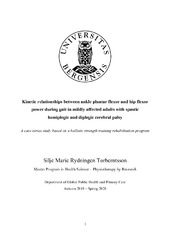| dc.description.abstract | Background: In normal gait, the ankle plantar flexors provide most propulsive energy during push-off, with smaller contribution of hip flexors. However, the interplay between these two joints remains unclear in spastic cerebral palsy. The objective of this study was to evaluate the kinetic relationship between the ankle plantar flexor and hip flexor power in late stance of gait (A2/H3) in mildly affected adults with spastic cerebral palsy. By implementing a ballistic strength training program, it was hypothesized that these exercises would exaggerate ankle plantar flexor power so the need for hip flexor power compensation would decrease, and thereby result in an increased A2/H3 ratio. Method: Ten adults with spastic hemiplegic and diplegic cerebral palsy, Gross Motor Function Classification System I-II, was recruited to attend an eight week ballistic strength training program mainly prescribed to most paretic limb. Three-dimensional gait analysis with a force plate was used to investigate the impact on ankle and hip power generation in push-off before, during and after intervention. At least three gait trials at self-selected speed was analyzed for each limb to calculate peak ankle and hip flexor power in the sagittal plane and relationship between them (A2/H3 ratio). Results: 7 participants completed the study protocol. 6 out of these 7 participants increased A2/H3 ratio on the most paretic limb, while 5 increased on uninvolved limb. As expected, the change was more evident on the most paretic limb compared to the uninvolved limb. Conclusion: Findings from this study provide a better understanding of the interplay between power patterns in the ankle and hip joint in spastic cerebral palsy with a possible implication to clinical practice. However, the results cannot direct any casual relationships between change in A2/H3 ratio and ballistic strength training. Until evidence is found, we assume that ballistic strength training is feasible to alter A2/H3 ratio in adults with spastic cerebral palsy, yet further analytic investigation is needed. | en_US |
